| Home for the Holidays |
Marcy Petrini
December, 2022
A couple of my teaching colleagues recently taught workshops on holiday weaving. What a wonderful idea! And what a great chance to introduce or review various weaving structures.
Our family celebrates Christmas, so my holiday textiles tend to be red, green and a white. Those also happen to be the colors of my native Italian flag! Home textiles are a great way to celebrate a holiday and a weaving tradition at the same time.
Here are some of my holiday textiles, using a variety of weaving structures.
In the 1990s when chenille was very popular, I used it as weft for plain weave placemats and table runners. Here are two examples for Christmas decorating.


Twills have great drape, so they are used for wearable accessories. They work equally well for home textiles. Here is a close up of an undulating twill cupboard runner.

Besides the usual home textiles, the holidays give us a chance for additional pieces. I used a plaited twill with a variety of greens in the warp and a red weft to make a Christmas tree skirt. Here is a close up of the fabric.

And a straight twill sash has been used for years to wrap a wreath on our front door during the holidays. It is a bit faded, especially the greens, but it is well loved.

I have used huck and other lacey weaves for home textiles, but somehow not for Christmas. However, last year, as I was getting ready for my Convergence seminar on rectangular float weaves, I wanted to weave huck lace stripes. A red holiday scarf was born, ready for that Christmas partying!

With more experience over the years, a little while back I tried weaving with linen using a simple damask (two blocks of satin, 10 shafts). Here is the front and the back of the table runner I wove. It’s one of my favorites.

Supplementary weft weaves make fabrics that are perfect for pillows because they tend to be thicker from the supplementary weft which is generally three times or so thicker than the ground weft. Here is a close up of a throw pillow, Monk’s Belt, ground red, supplementary off white, reversed from the traditional way to weave it.

Tied-unit weaves also use a supplementary weft. When I was first learning about them on multi shafts, I made this Tied-Lithuanian runner, to honor the other side of my family, Mom is Lithuanian. The runner is a bit thick, and it probably would have been better as a pillow, but it is serviceable. And I like the design on 10 shafts. Here is a close up of the motif.

I have just scratched the surface here! Granted, it’s a bit too late to start weaving for the 2022 holidays, but 2023 will be here in no time. And as I always like to say: if you make the warp red, Valentine’s Day is just around the corner!
Happy Weaving and Happy Holidays!
Marcy
| Satisfied or Not? |
Marcy Petrini
November, 2022
Early in my weaving life, I took an inspirational Convergence seminar from Anita Luvera Mayer (see her recent HGA Textile and Tea: https://www.youtube.com/watch?v=CMhJDW6Smmg )
Something she said really resonated with me: if you are satisfied with every piece you make, you are not growing enough. And she quoted one out of three. It wouldn’t seem that one satisfactory project for every three would be a good measure of success, but if we think about baseball, a batter who gets on base one third of the times is very successful!

I don’t think Anita meant that out of three, one piece was worthy of a museum exhibit – but it could be – and that the other two would be headed for the garbage. Rather, we should have a vision, a plan, or an idea of what we want to accomplish with any given weaving. That is the benchmark by which we can determine whether we are satisfied or not. Some weavers are supercritical of their work, but saying “I don’t like it” or “it didn’t work” is not very helpful for growth.
I follow the advice that I give to others when I teach critiquing your work. For every piece that comes off the loom, whether I am satisfied with it or not, I ask myself: if I were to weave this again, what would I do differently? Chances are that if I am satisfied with the project, what I would do differently is a small tweak. And then there are the others….
I have been mesmerized by the wonderful pictures that the James Webb telescope is sending back – and the universe that they represent. I wanted to capture some of them in a weaving.

Here is the scarf:
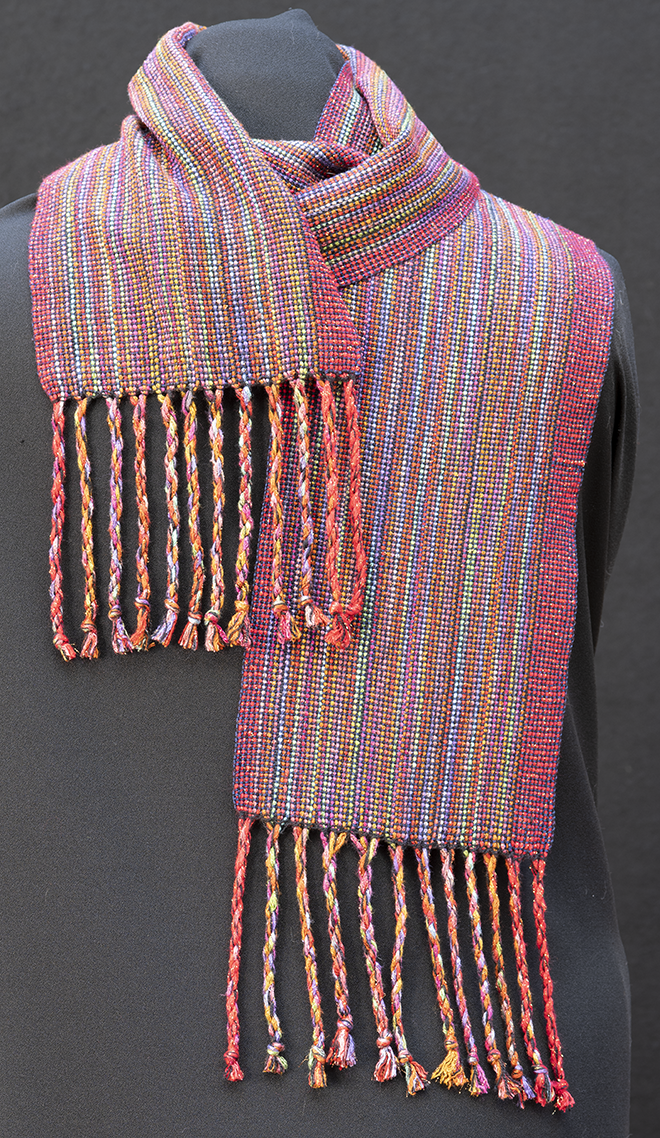
It works as a scarf, pretty good drape, colorful. I was hoping, however, to capture the darkness of the universe and the points of light that we can see in some of the pictures. For that I failed miserably. Where did I go wrong? Poor decisions all along the way!
First poor decision: not enough darkness. My original idea was to alternate one thread of 20/2 black silk with a 20/2 silk thread of a different color. Perhaps not a different color with every alternating thread, but using a few ends of a variegated red, then a variegated blue, etc. Then the weft would be 20/2 black silk. I could add the shininess of the galaxies by using some metallic thread along with the silk weft. With plain weave, the fabric would be little boxes of color in the midst of black.
While threading I decided that I could shift the color boxes a bit if I periodically put two black warp ends together and two colorful ends together. I am not sure that this decision added anything to the design, but that’s what the drawdown below shows.

Neither this nor the original draft that had strictly alternating colors really captures the darkness of the Webb pictures we see. More black warp ends would have been better. But I didn’t notice, and I moved forward.
Second poor decision: changing the size of the colorful warp ends. As I was gathering 20/2 variegated silks, I came across a yarn in my stash, Blue Heron rayon metallic, color way "Parrot". Perfect I thought, colorful and shiny. I had used this yarn before for warp and weft and it had worked well. I had also used the Blue Herron in a red colorway as weft on a 20/2 silk warp. Even though rayon can be dense, the scarves I had woven had good drape.
The yarn, however, is larger than 20/2 silk. In fact, it wraps at 24 epi; I had sett it at 12 epi for the plain weave scarf that used it for warp and weft. For this scarf, I was planning a sett of 24 epi (wraps at ~48 epi) for the 20/2 silk. With the larger yarn I had to change the sett. Some calculations (something went right!) I decided on a sett of 18 epi.
The Blue Heron was left over from the previous project. From a back-of-the-envelope calculation, I figured out that I had enough rayon for the warp to alternate with the silk.
Third poor decision: bad arithmetic and scale. I wound approximately 6.5” and I ran out of Blue Heron! The scarf was supposed to be 8”. I decided to finish the inch I was winding with the Blue Heron red colorway, which is also metallic. I needed just four ends of the red.
However, now the scarf had a stripe on one edge. I decided to wind a separate inch for the other side. This way, I would have 8”. Furthermore, the switching of the color design would be balanced. One side has four reds, the other nine, not a whole lot of difference – I thought.
I use a lot of 20/2 silk sett at 24 epi or closer, so from experience I know that the difference between four and nine threads is 3/16” or less, which is probably not noticeable when wearing a scarf.
However, this warp was sett at 18; that alone would make the two sides different by ¼”, which starts to be noticeable. But the red rayon was threaded for every other warp thread. Thus, the four-thread side stripe is less than ½” wide, while the nine-thread side is 1” wide.
This is clearly visible in the scarf below, but I only noticed after the scarf was off the loom.

Fourth poor decision: a weft that doesn’t show. I had planned 20/2 black silk as weft, but when I started weaving, I realized that the weft was not very visible, and the colors stood more than I had planned. I found some 8/2 dark blue silk and used it instead. Up close while weaving, the larger weft worked better, but from the scarf you can see that it is not very noticeable.
Now I know what I should have done, and what I would do if I were to weave it again…. Maybe I will…..
Happy weaving and happy holiday season!
Marcy
| Motif Reprise |
Marcy Petrini
October, 2022
Do these two motifs look similar? I call the second, the red and green one, a reprise of the first, the blue one. They are both extended undulating pointed twills. In the red one, the pointed twill motifs are interrupted by a stripe of green broken twill. The undulation in the threading is a bit different between the two and the treadling has extra steps in the second.


The blue drawdown was in the August blog as I showed how I “downsized” the draft from my 40-shaft shawl “Ripples on Knoxville Lakes” to 8 and 4-shafts versions. I never wove those versions as they were just to show how designs can be made successful with fewer shafts. The motif, however, remained in my mind until it evolved into the second drawdown.
During HGA’s Weaving and Spinning Week, I gave an “Art Spark” talk entitled Where Does Inspiration Come From? The scarf I wove using that motif is another example.
The inspiration came from the amaryllis shown in the picture below, photographed by my husband Terry Dwyer.

I love flowers but I am not a gardener, I like to say that I have ten purple thumbs. Luckily, I am married to a gardener who keeps flowers in our yard nearly year-round.
I am particularly fond of amaryllis because my Father-in-Law used to send them to us for the holidays when we couldn’t be together. The red and green may be reminiscent of Christmas, but we have lots of red flower in the garden and I think of the red and green as colors for all seasons.
As I sat down to figure out what structure would be good to depict this flower, I returned to the extended undulating pointed twill from the “Ripples on Knoxville Lakes” shawl. The green broken twill surrounds the red motif, as the green leaves surround the flower in the picture; the center of the twill is salmon to reflect the pistils of the amaryllis.
There are many ways of extending twills, especially pointed twills. There are many ways of undulating twills. Taken together, the possibilities abound. In both cases I repeated the undulation to the extended legs of the twill, but it wouldn’t have to be the same or symmetrical. Maybe this motif will come back later….
The scarf is 10/2 silk warp and weft. The warp is variegated red, the weft is a red with a bit of orange, slightly variegated. The green stripes are also variegated. Here is the scarf.

And here is the close up:

Happy Weaving!
Marcy
| To Sample or not to Sample: That is the Question |
Marcy Petrini
September, 2022
I am a big proponent of sampling. I sample for my Pictionary©, my teaching, and my other writing. I also sample yarns I haven’t used before, or yarns I haven’t used with a structure I am planning. I sample color combinations on warps for my scarves and shawls.
There are two circumstances when I don’t sample. One is when I am familiar with the yarn, and I plan to weave the same type of structure I have woven before. The other is if I have a special yarn in limited quantities.
When I start a project with a familiar yarn, I know the sett, and I can calculate the width and length on the loom. This is because for every project I measure the finished dimensions off the loom and then again after wet finishing. I like to measure take-up and shrinkage separately because I believe that they are the results of two different processes.
The take-up is from the geometry of the cloth. The warp is straight on the loom, the weft is straight when we place it in a shed. However, to be incorporated in the cloth, the threads must go over and under each other in paths that are no longer straight, as shown in the diagram below.

Some structures have more take-up than others. Think of honeycomb vs. plain weave. Width-wise there can also be drawn-in from the weaver; if we don’t leave enough weft in the shed for its undulating path in the cloth, the warp edges are pulled in by the weft.
Shrinkage is a function of the fiber as well as how we wet finish the piece. For example, given a cloth of unmercerized cotton and another of mercerized cotton, the first will shrink more than the second, even if the take-up was the same.
After weft finishing, I look at the hand of the fabric to determine whether the sett and beat were the best for my intended use of the cloth. In the future I can use that information to plan accordingly.
If I have a yarn of limited quantity and I am not willing to sample, I approach it with three goals in mind. First, I research it as much as possible to see how it compares to other yarns I have used in the past. Second, I am willing to change plans mid-course. Third, I know that the final product may not be the best, but hopefully it will be good enough for its intended use and a good learning experience.
A recent project shows my approach to not sampling.
This past spring, I received as a gift from a dear friend a yarn called Rose by CarrPark Artisans. The yarn is a rayon made with rose petals, a totally new yarn to me! The yarn’s colorway is Rosy Outlook, variegated pink, blue, purple and gold. It is not pastels, but not very bright either, a wonderful mix reminiscent of spring.
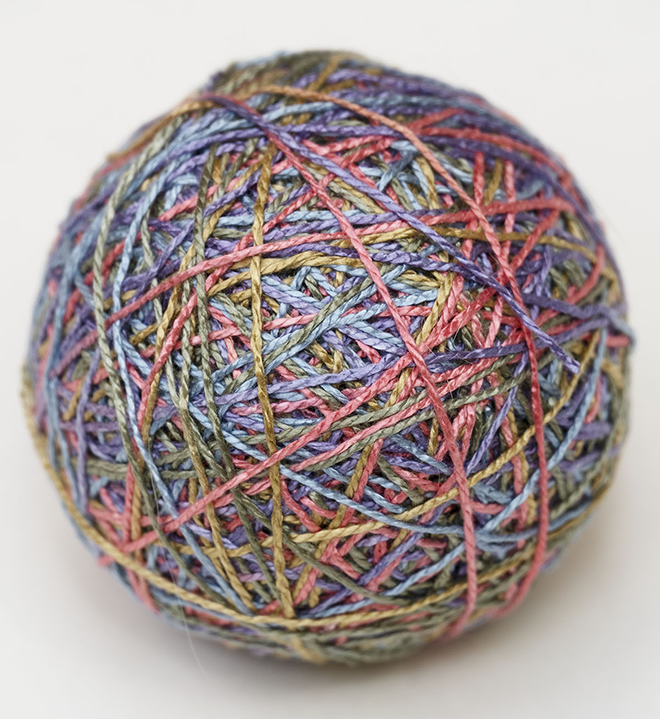
The yarn is labeled 5/2 and since rayons follow the cotton system, I believed that the range for sett may be 12 epi for drapey plain weave all the way to 24 epi for an unbalanced twill. Next, I searched the website for more information and that’s where I found that the yarn had been discontinued. Now my thinking changed. I had 1,000 yards, enough for a warp for two scarves, but if I sampled, I wouldn’t have enough for the second scarf. My compromise was to weave a scarf as a “sample” and then weave a second making any necessary adjustments, There would be more work involved, but not much loss of thread because I would have to leave enough warp between the two scarves for fringes and that’s pretty much what is needed for loom waste.
I didn’t want the colors of the yarn to be too diluted by the weft. I thought of using the sett close to the wraps per inch, and then using a much thinner weft. I have done that with other yarns and the pieces have drape if the sett is not too close and if the weft is not a dense yarn.
Here is an example from my rigid heddle, still in progress. The warp is a brushed silk and the weft is 10/2 bamboo from SWTC which has been on a shelf for a while. The warp variegation is not mixed by the weft.
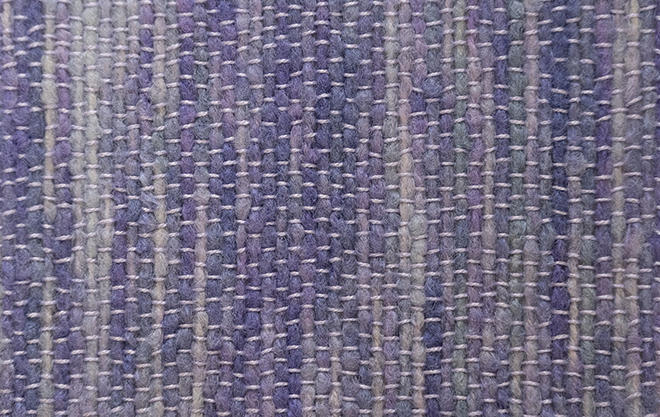
For the Rose yarn, I had these parameters in mind. First, a rather close sett at 24 epi for the warp, so it would be less visually blended by weft. Second a thin weft for the same reason; I thought a 20/2 silk would work, and silk has good drape.
Third, because the yarn is shiny, it would benefit from a twill with uneven lengths of floats, and twill lines with different directions. The pattern wouldn’t be visible because of the variegated warp, but the twill will reflect the light at different angles making the fabric shimmer.
I chose the extended interrupted pointed twill below. By tying treadle 5 same as 3 and treadle 6 same as 2, the treadling is easy, going from 1 to 6.
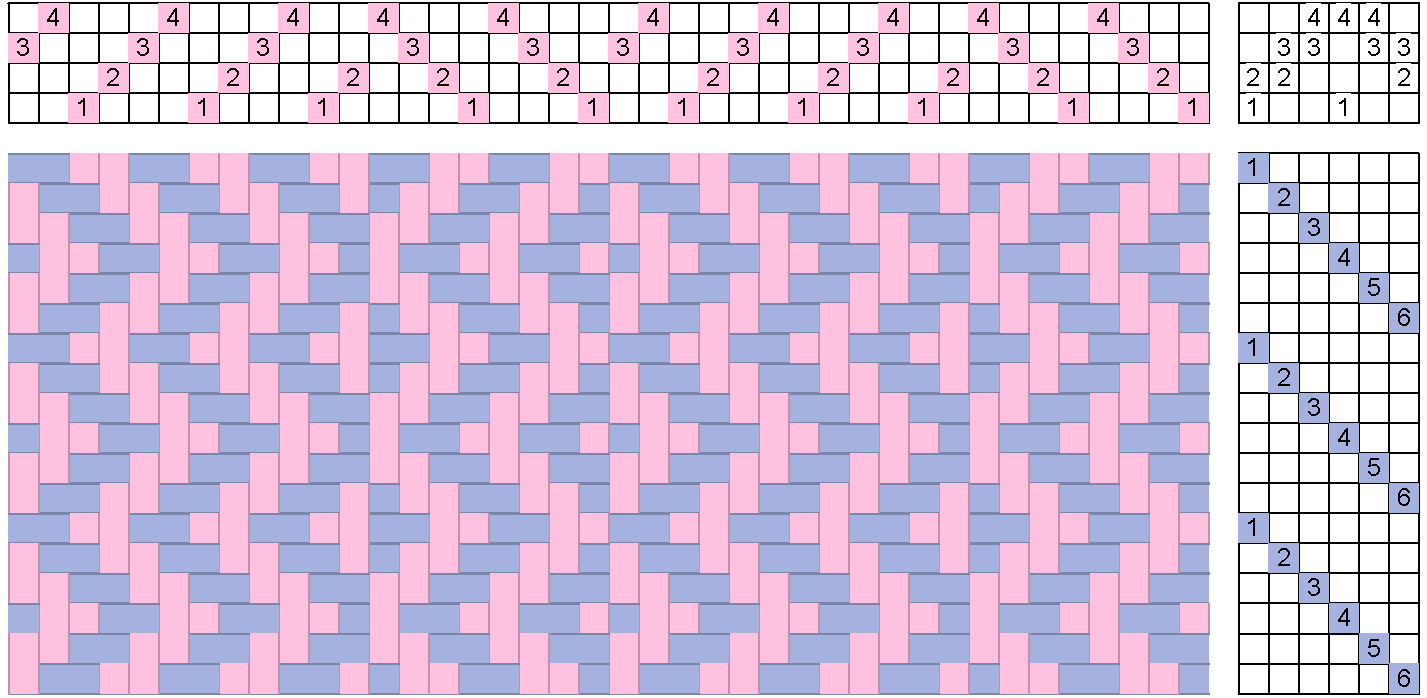
I chose a lilac 20/2 silk that compliments the warp, and the weaving finally began. After a few inches, it was clear that this project wasn’t working. I have woven warp dominant scarves and shawls before with good success. I have used wool, cotton ribbon, 5/2 silk, among others, but always in plain weave. I am not sure whether the problem here was that the warp is dense, the structure is a twill, making the fabric heavier, or the difference between warp and weft is not enough. The fabric looked fine, but it just didn’t have enough drape, I could tell by feeling it.
No sample, so my goal number two for this project was to change course. I thought of several options, slept over it and finally decided that the only way it would work for what I wanted was to unweave, untie, undo the hem, and re-sley the warp at 18 epi which is generally a good sett for a 5/2 yarn in the cottons system. To preserve the colors, I would have to use the same yarn for weft.
This is not ideal but to save on the yarn, I used as part of the weft the left-over warp yarns from the re-sleying.
Here is the final scarf, followed by a close up.
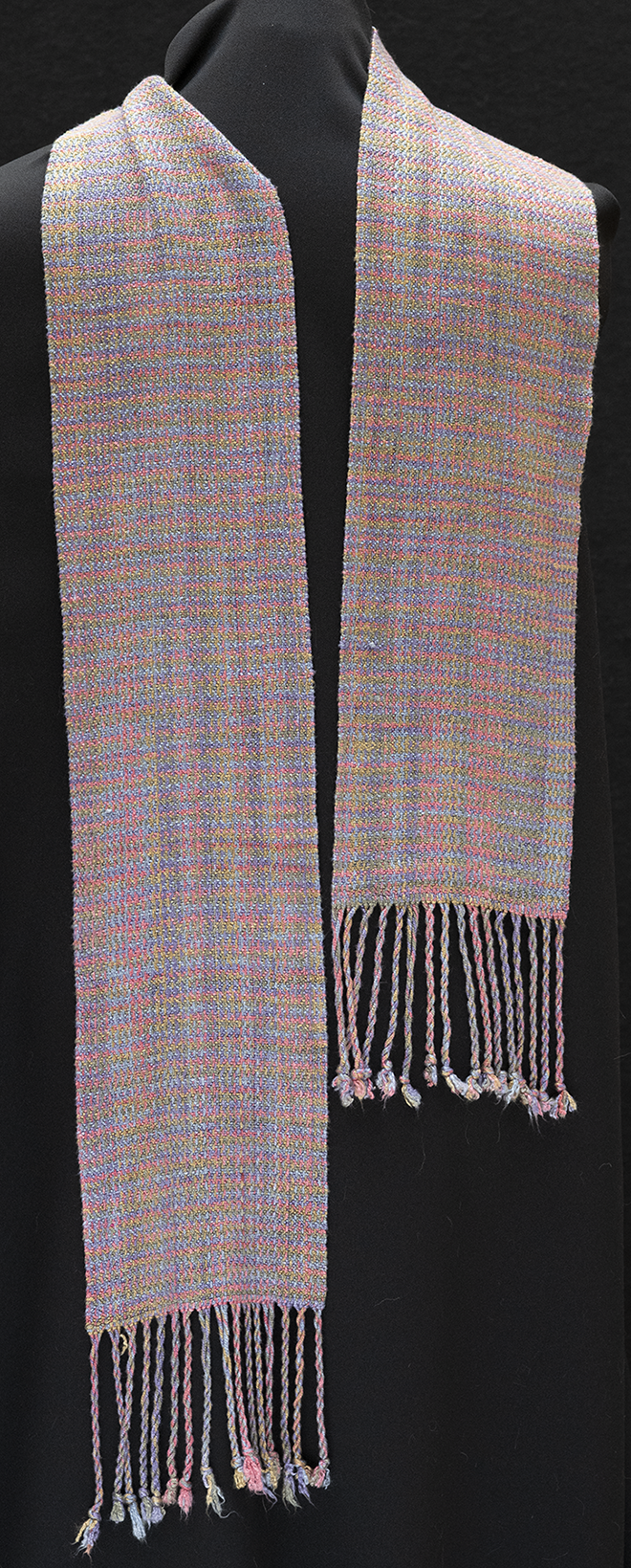
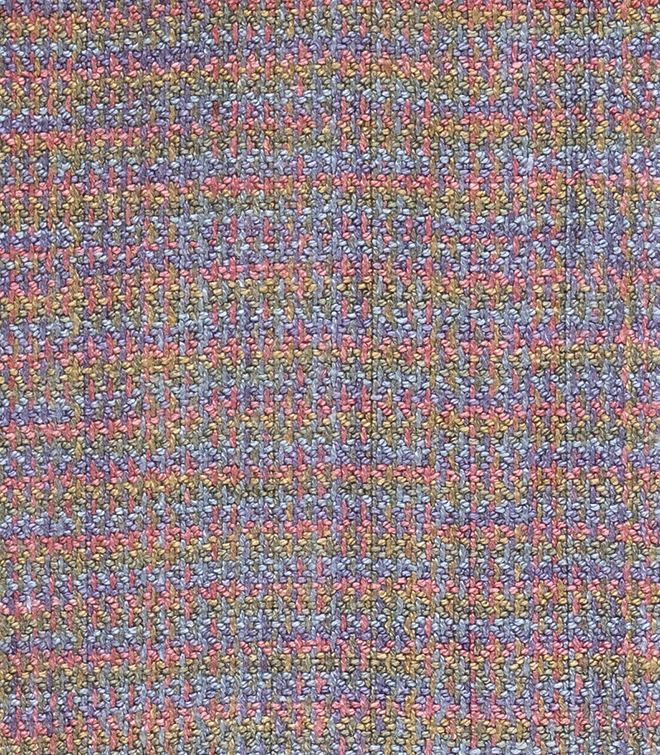
Despite changing course, I like the scarf. It has good drape, and the colors are unmixed. I often use a variegated weft with a variegated warp, sometimes different yarns. I don’t try to have the yarn be continuous. I like the serendipity of the random stripes.
Would have been better to sample? Maybe and maybe not. I learned a lot about the yarn this way, and it may have taken more than one sample to arrive at a solution. I do have enough yarn that I can use for a future project which I need to plan carefully.
Next time you are faced with the decision to sample or not to sample, think about this process and whether it would work for you.
Happy Weaving!
Marcy
| From More to Four |
Marcy Petrini
August, 2022
At Convergence® last month I wore this shawl which I had named “Ripples on Knoxville Lakes.” I had originally planned to submit it to the fashion show, but life interferes with weaving sometimes and the shawl got barely finished in time for the conference. Instead, I wore to the fashion show event.

On the way there I met a colleague who admired my shawl and asked: “Eight shafts?” “No, I said, forty.” “Oh, she replied, I will never be able to weave that.”
That’s true and it isn’t. She wouldn’t be able to weave that exact shawl unless she had 40 shafts, but the idea of the shawl came from the many lakes in the Knoxville area, and I imagine ripples any time we have standing water. The concept of ripples on water, however, can be woven with many fewer shafts.
For the 40-shaft version I started with a pointed twill in the threading and treadling, and then I “played with” the tie-up which I then converted to a lift plan. The drawdown is below.
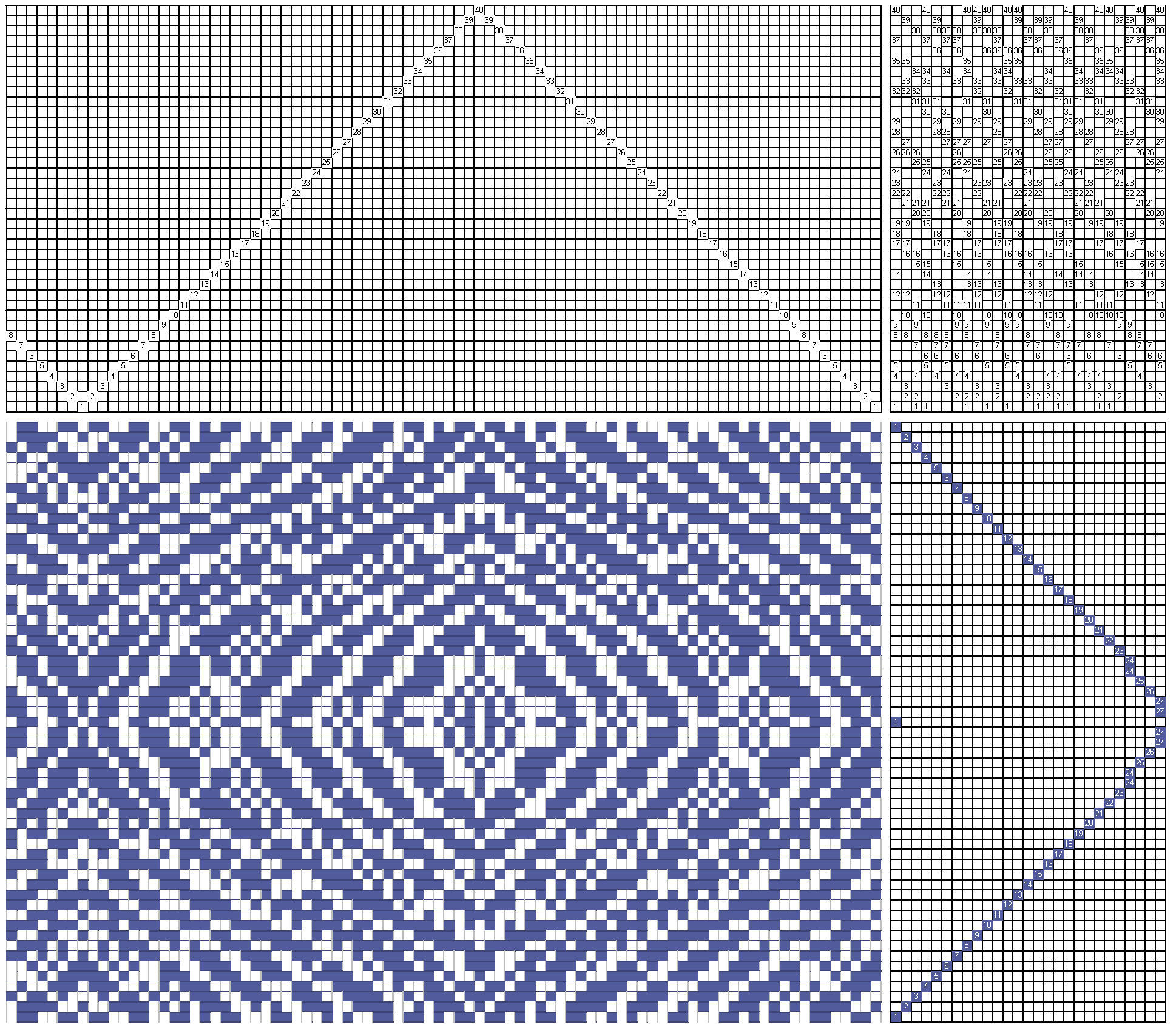
Here is a close up of the fabric. The warp is Tencel™, variegated and dyed by my friend Margaret Pittman. Sadly, she is no longer able to dye. She called this yarn Atlantic Moonglow with purples, and blues. The weft is 20/2 lilac silk.
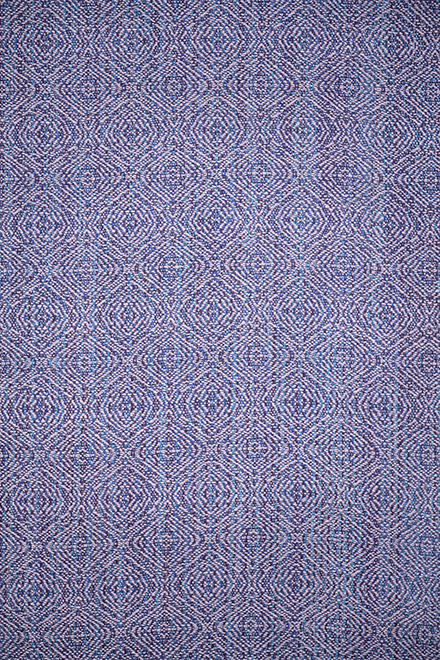
In response to my colleague, with fewer shafts, what could we could weave?
With fewer shafts, I find it easier to manipulate the threading.
For an eight-shaft version, I started with a pointed twill as shown below with the intention of making it a diamond which then can be rounded in some way, the same thought I had when designing the 40-shaft version.
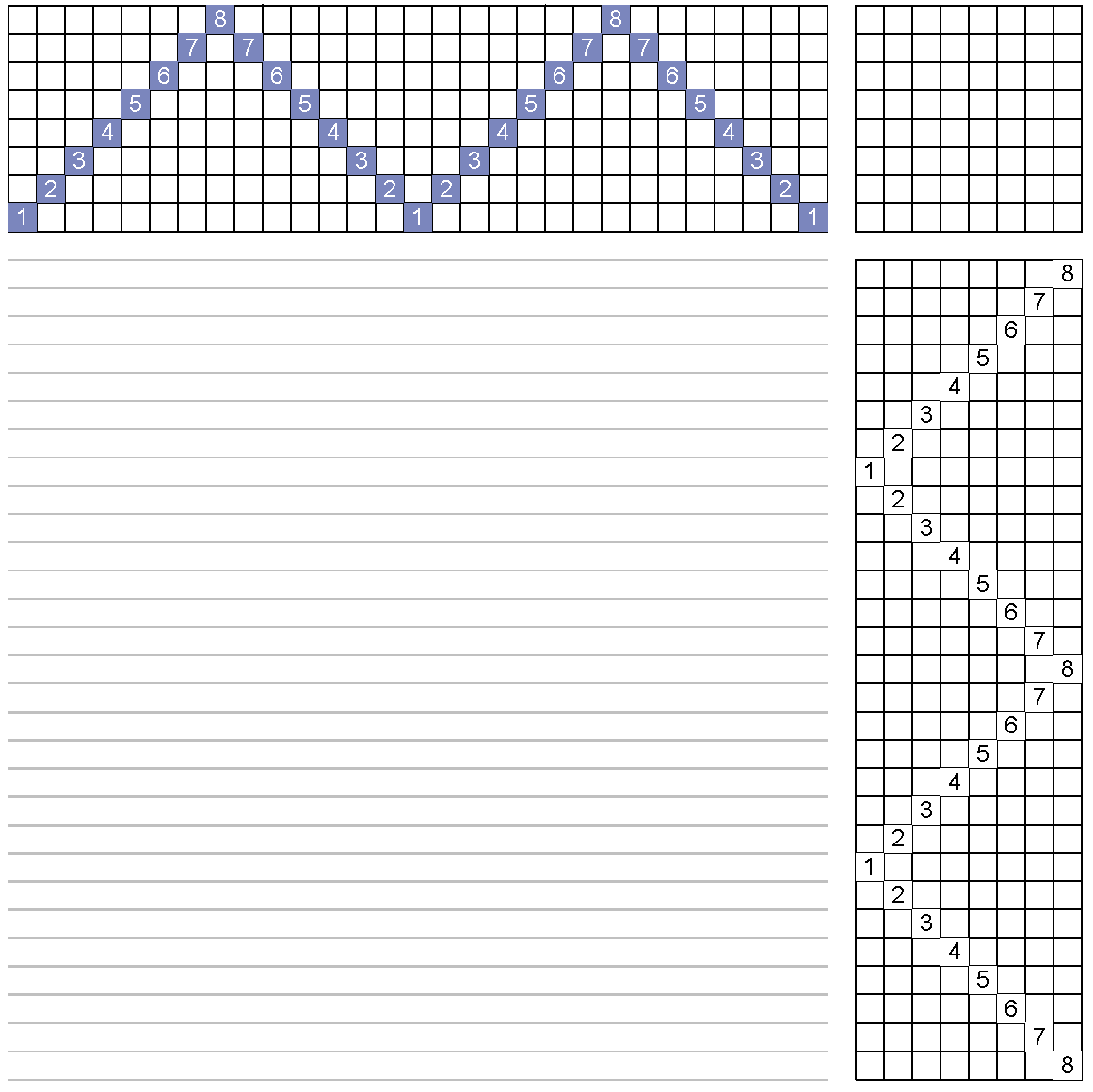
To round it, we can elongate the threading or the treadling or both. With fewer shafts I generally prefer to manipulate the threading, so I can think of my motif even before I consider the treadling steps.
As shown below this becomes an undulating pointed twill. In my experience with undulating twills, the floats can get so long to make the fabric unstable. Here I chose to double the threads on shaft 4 and 6. For a more rounded shape, we could triple some and double others, but again, long floats have to be assessed.
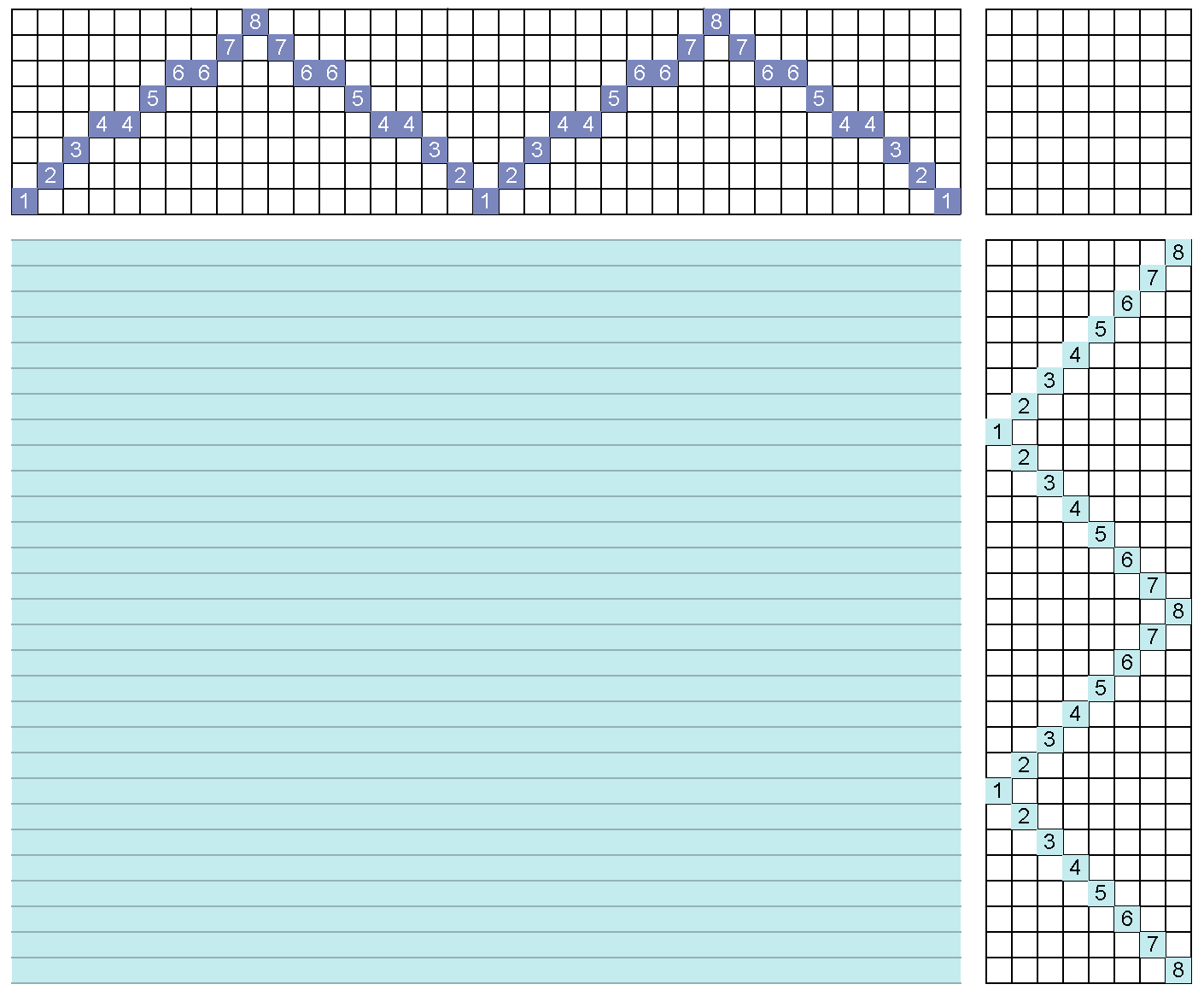
Next, I chose a tie up. In this example I started with 2/1/2/3. I then placed an additional tie on shaft 4 to delimit the float. This way there aren’t any floats warp or weft-wise longer than 5 threads. Depending on the sett of the warp, that number could be larger for a close sett or smaller for a wider sett. Below is the drawdown for this step.
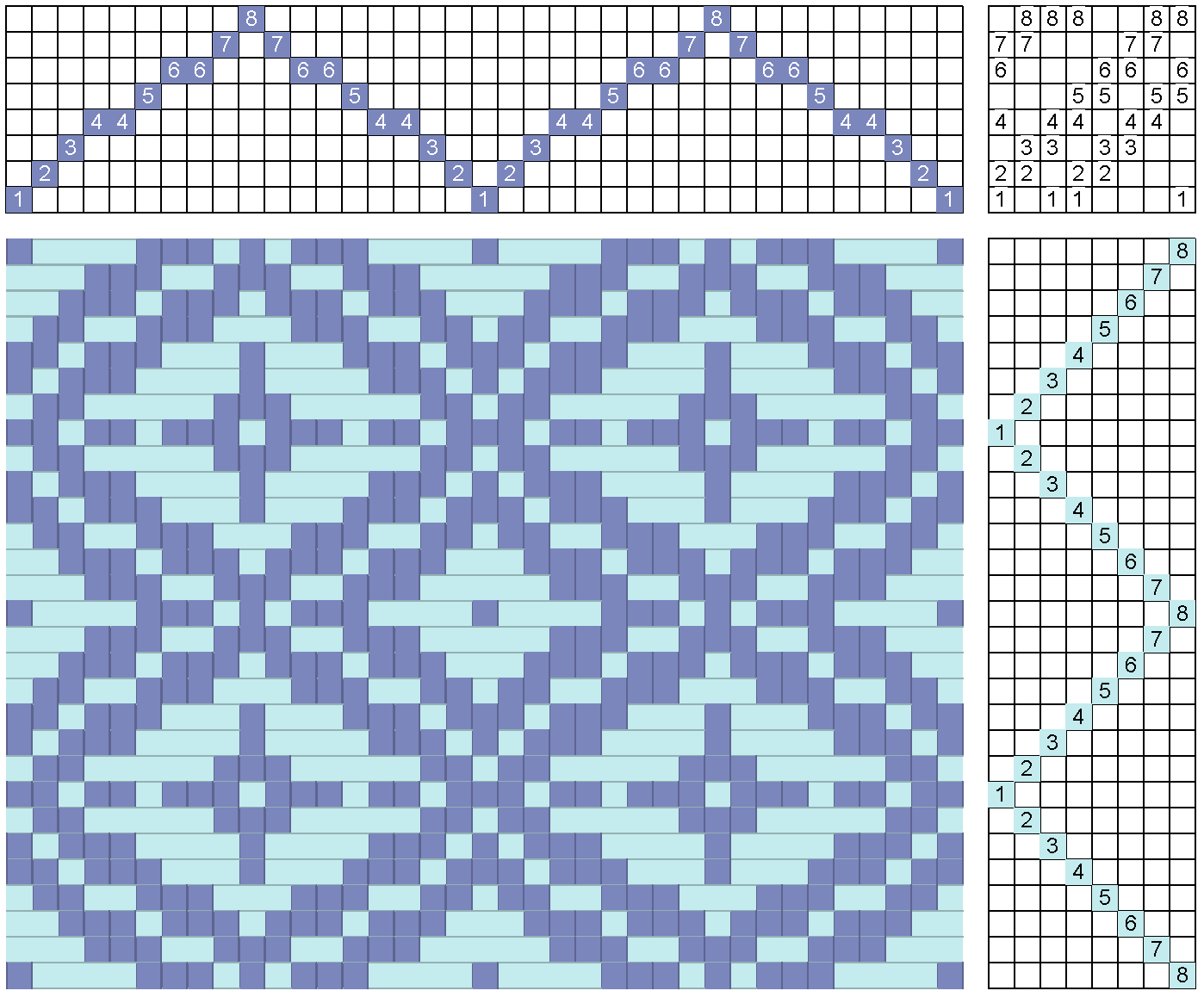
Looking at the drawdown, we see that there are two concentric rounded figures, not quite circles for sure, but reminiscent of a ripple. But we could add more, as shown below.
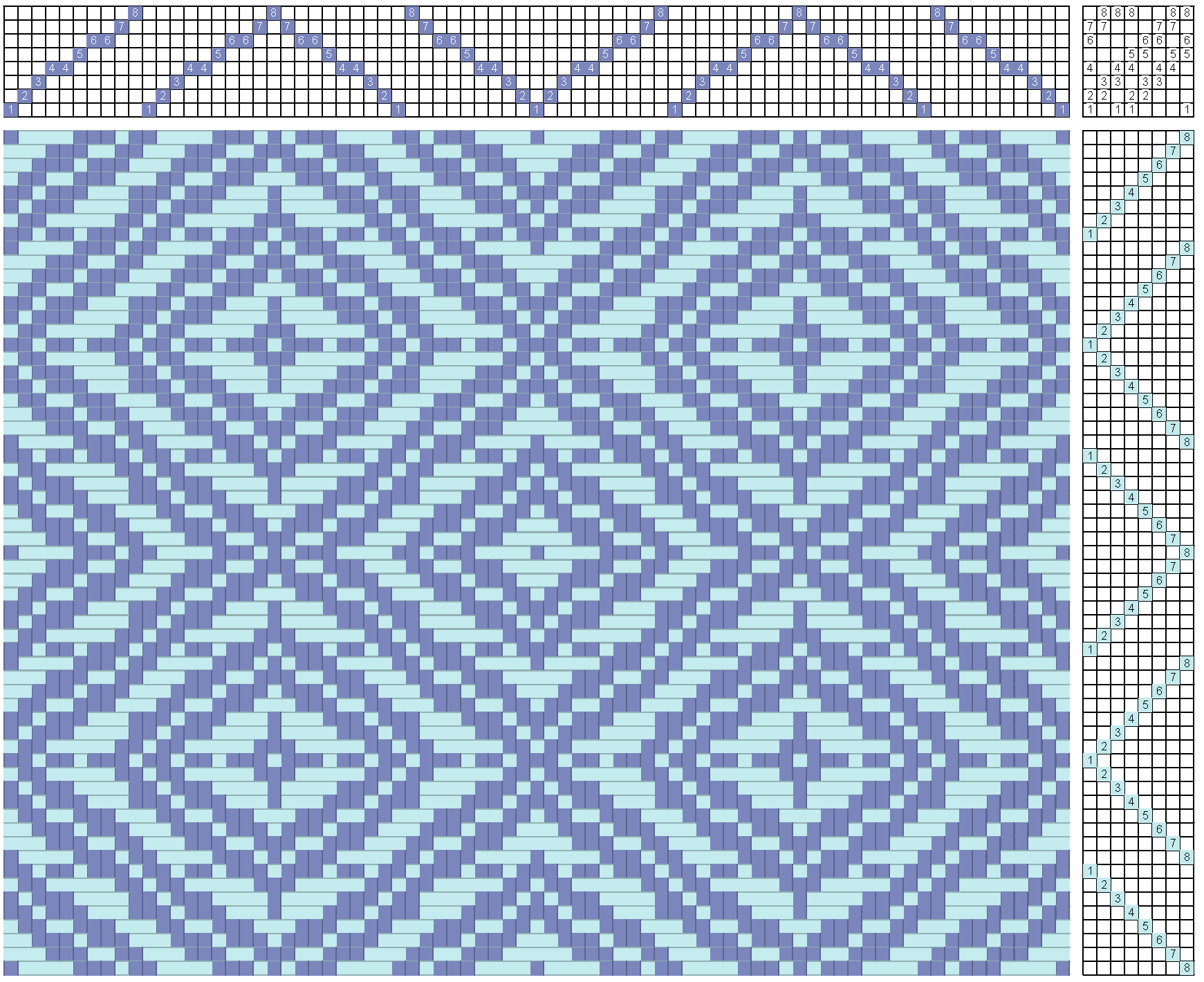
This is an extended undulating pointed twill. There are other options, of course, but the process to design the motif is the same.
What about 4 shafts? The process is the same here, too.
Instead of a pointed twill, I started with a bird’s eye twill, so the repeat is longer and there will be a nice center. I used the traditional bird’s eye twill treadling with the 2/2 tie-up, as shown below.

Next, I doubled threads on shafts 2 and 4, rounding the appearance a bit. Not doubling adjacent shafts avoids long floats. In this example there are no floats longer than 5 thread long.

Here is my final version: an extended undulating bird’s eye twill. It could be rounded more, but I will leave that up to you.
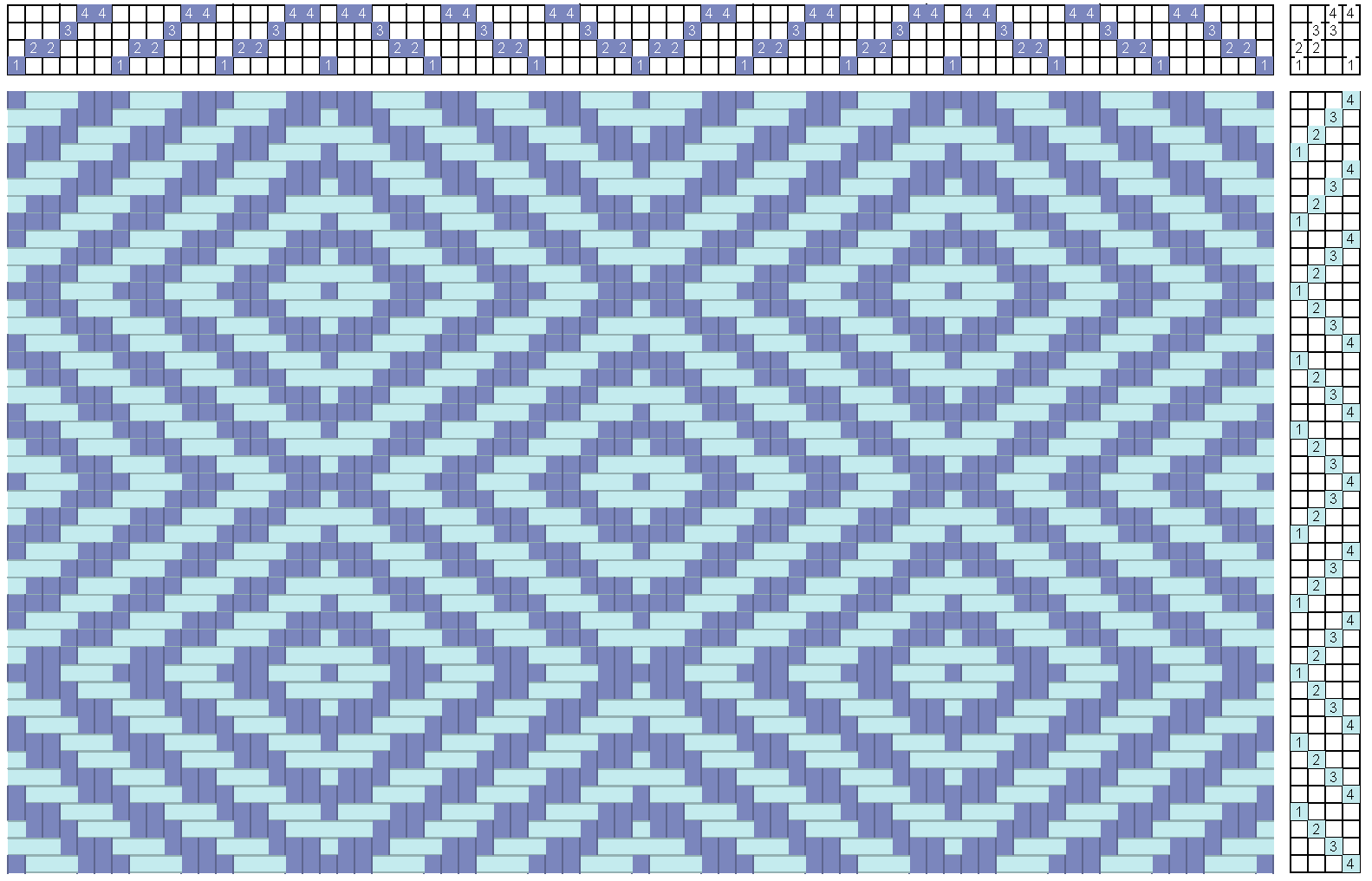
And, yes, you could weave this on a rigid heddle loom. Guatemalan and other native weavers do amazing designs with a pickup stick. It does require some patience.
Twills that have lines going at different angles change how we see the pattern and the color that they reflect, especially as they move. If we use shiny yarns, as I did in my shawl with Tencel™ and silk, there are actually two types of reflectivity: one is the usual light bouncing back from the color not absorbed. We see the purples and blues in my shawl. The other is called specular reflectivity which is ambient light that shines back (“Specular” comes from the Latin word for mirror, and specular light results from reflections as if by a mirror). The shawl appears lighter in spots where specular reflections bring out highlights – especially at the folds. Luminescence can result from these visual effects.
The process I have described here to obtain rippling can be applied to many other motifs. Drawdown software is very useful.
Happy Weaving!
Marcy
